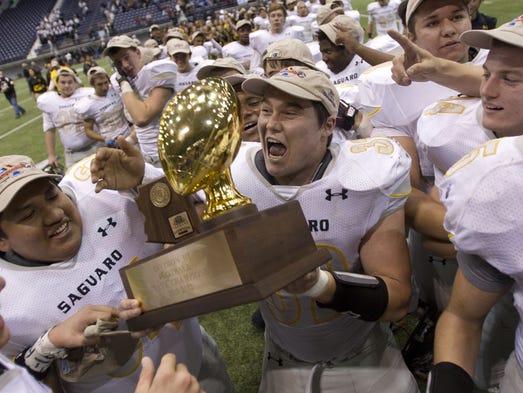Bordow: Rattler, Barcello see sports specialization differently – AZCentral.com
They are two of the most successful high school athletes in Arizona.
Spencer Rattler is a highly recruited quarterback for Phoenix Pinnacle. Sarah Barcello has been one of the stars on a Chandler Seton Catholic’s girls basketball team that has won three state titles in four years.
They have much in common, including a passion for their sport, an uncompromising work ethic and, soon, a college scholarship.
But there is one fundamental difference between the two: Rattler also plays a winter sport – basketball – for Pinnacle. Barcello has focused solely on basketball since the fifth grade.
MORE: Arizona’s top high school football prospects – 2018 class
Their divergent paths illustrate a conundrum faced by a lot of families: Should their children concentrate on one sport or play multiple sports?
Two recent studies revealed some interesting answers to that question. The NCAA surveyed 21,223 athletes at Division I, II and III universities. The study showed that in women’s gymnastics, men’s and women’s soccer, men’s and women’s tennis and men’s ice hockey, at least 55 percent of the respondents were one-sport athletes by the age of 12.
Conversely, 71 percent of football players and at least 83 percent of men’s and women’s lacrosse players and men’s and women’s runners were multi-sport athletes growing up.
A second study was conducted by doctors at the Rothman Institute at Philadelphia’s Thomas Jefferson University. It surveyed 503 high school athletes, 856 collegiate athletes and 1,731 pro athletes. Among its findings: High school athletes began specializing at an average age of 12.7, compared to college athletes at 14.8 and pros at 14.1.
The conclusion the doctors reached: “This data challenges the notion that success at an elite level requires athletes to specialize in one sport at a very young age.”
RELATED: Decades-long track records holding up in age of specialization
Rattler would seem to be the ideal one-sport athlete. He already has football scholarship offers from a bevy of Division I universities, including Arizona State, Arizona, Texas A&M and UCLA. Why risk injury playing a second sport?
Rattler, however, sees it differently. He loves basketball. Why not enjoy playing both sports while he still has the opportunity?
“I’ve always wanted to do as many sports as I can,” said Rattler, who also was a soccer and baseball player growing up. “I’ve never really focused just on football. Whatever season I’m in, I’m hyped up about it.”
Rattler said his parents always encouraged him to play multiple sports. So has Pinnacle football coach Dana Zupke. He tells his players that when college recruiters walk through his door their first question is, “What’s the kid like?” Their second question: “Does he play more than one sport?”
“I hammer this to our kids: Play other sports,” Zupke said. “It’s the only time in your life you’re going to be able to do this.”
Rattler believes playing multiple sports helps him avoid injury. A recent study by the University of Wisconsin found that high school athletes who specialize in one sport are 60 percent more likely to suffer lower-body injuries.
“I think the two sports feed off each other,” Rattler said. “Basketball helps with my footwork and the strength training in football helps me on the basketball court. I feel like kids who just play basketball or football year-round tend to get hurt more.”
Barcello and her father, Edward, know that college coaches prefer multi-sport athletes. They also are aware that high school athletes who specialize in one sport are at greater risk of injury.
But Edward Barcello said that after Sarah ditched soccer for basketball in the fifth grade and showed an affinity for the game – not surprising given the success of her older siblings, Julia and Alex, at Seton Catholic and Tempe Corona del Sol, respectively – the family decided it was best that she only played basketball.
“Once they get close to high school, I’m like, ‘Do you want to be good at several sports or do you want to be great at one sport?’ ” Edward Barcello said. “That’s the decision you have to make.”
Sarah Barcello, who averaged 18 points and seven rebounds a game for Seton this past season, said she never regretted giving up soccer. Nor did she ever consider playing a second sport. Her reasoning: “Basketball is already very taxing on my body. I need those extra months off to rest instead of pushing it. I can kind of relax and recover.”
Edward Barcello said he and his wife make sure Sarah has scheduled time off during the year. He said she doesn’t play for a month after the high school season ends, and she is also shut down in August and some of September after the club season ends.
In addition, Sarah Barcello plays for a club team, the Oakland Soldiers, which only plays during viewing periods for college recruiters as opposed to participating in tournaments every weekend.
“You can’t just play that one sport year-round, 12 months a year,” Edward Barcello said. “You have to do other things for fun or you’ll get burned out. You have to take a break.”
Clearly, things have worked out well for both Rattler and Barcello, who was the azcentral.com Sports Awards’ Big Schools Girls Basketball Athlete of the Year as a sophomore. Even in hindsight, neither would change the decision they made when it comes to sports specialization.
“I’m glad I stuck with basketball,” Barcello said.
“I’m very happy I’m still playing two sports,” Rattler said.
The bottom line: There’s no one true path. It’s about making a smart and educated decision. And listening to the person that matters most:
The student-athlete.
MORE BORDOW: Final Four a homecoming for Oregon’s Casey Benson
Reach Bordow at scott.bordow@arizonarepublic.com or 602-448-8716. Follow him at Twitter.com/sBordow.



































